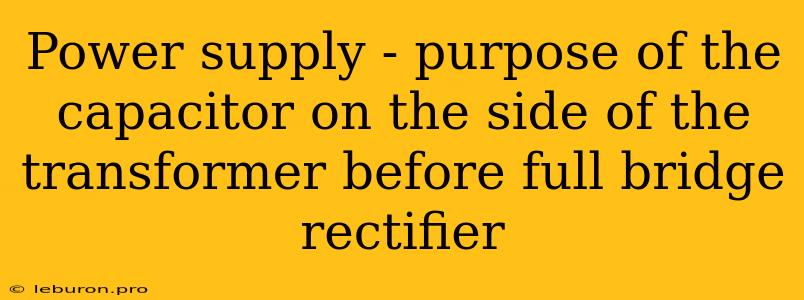Understanding the Capacitor in Power Supplies: A Deeper Dive
Power supplies are essential components in electronic devices, converting AC (alternating current) to DC (direct current). A key element within this conversion process is the capacitor placed on the secondary side of the transformer, before the full-bridge rectifier. While often overlooked, this capacitor plays a crucial role in smoothing out the rectified DC voltage, ensuring a stable and usable power source for the circuit.
The Importance of the Transformer
The transformer is the first step in a power supply, responsible for reducing the high voltage AC from the mains to a safer and usable level. The secondary winding of the transformer outputs AC voltage, which is then fed into the rectifier.
Rectification and Ripple
The full-bridge rectifier, consisting of four diodes, converts the AC voltage into pulsating DC. This pulsating DC, however, is not yet smooth and stable. It exhibits a ripple voltage, which is a fluctuation in the DC output, often described as an AC component superimposed on the DC. This ripple can be detrimental to sensitive electronic devices, causing malfunctions or unpredictable behavior.
The Capacitor's Role in Smoothing
This is where the capacitor on the secondary side of the transformer comes into play. This capacitor, typically an electrolytic capacitor, is connected in parallel with the output of the rectifier. It acts as a reservoir, storing charge during the peaks of the rectified waveform and releasing it during the troughs.
How it Works:
- Charging: During the positive half-cycle of the rectified waveform, the capacitor charges up to the peak voltage.
- Discharging: During the negative half-cycle, the rectifier outputs no voltage. However, the capacitor continues to provide voltage to the load, slowly discharging.
- Smoothing: The capacitor smooths out the ripple by filling in the gaps between the peaks of the rectified waveform, resulting in a more stable DC output.
Factors Affecting Capacitor Selection
The choice of capacitor for this application is crucial. The following factors must be considered:
- Capacitance: A higher capacitance value leads to greater smoothing capability, reducing ripple but also increasing charging time.
- Voltage Rating: The capacitor must be rated for a voltage higher than the peak voltage of the rectified waveform to avoid damage.
- Ripple Current: The capacitor needs to handle the ripple current, which is the current flowing through it due to the ripple voltage.
Benefits of Using a Capacitor
- Reduced Ripple: The capacitor significantly reduces the ripple voltage, leading to a cleaner and more stable DC output.
- Increased Output Voltage: The capacitor maintains a higher output voltage than the average voltage of the rectified waveform.
- Improved Circuit Performance: A stable DC output improves the reliability and performance of the circuit, ensuring proper operation of electronic devices.
Choosing the Right Capacitor
Selecting the appropriate capacitor for a power supply depends on the specific requirements of the application. The type of device, its power consumption, and the desired level of ripple reduction all influence the choice. Consulting datasheets and considering the factors discussed above is crucial for optimal performance and safety.
Conclusion
The capacitor placed on the secondary side of the transformer in a power supply plays a critical role in smoothing the rectified DC voltage. It acts as a buffer, storing and releasing charge to minimize ripple and create a stable power source. Understanding the function and selection of this capacitor is essential for designing efficient and reliable power supplies for electronic devices.
